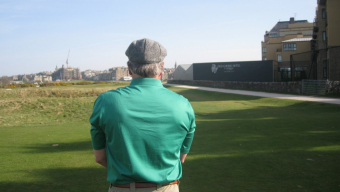Editor’s Note: During this difficult time dealing with the Coronavirus outbreak, leaving golf writers nothing to write about, we decided to revisit some of the places we have gone over the years. Beginning today, we return to our April 2012 father-son trip to Scotland, the home of golf).
First in a series
ST. ANDREWS, Scotland – No one plays in venerable old Yankees Stadium anymore. And even if you could, you can’t. You can’t even play in the new one. That was built specifically for Major Leaguers, guys who have earned the right to be there. The rest of us are in the cheap seats.
Same rule applies at Lambeau Field in Green Bay. Stay off the tundra. You can’t play a match at Wimbledon or Wembley. You can’t drive at Darlington or Daytona. Stepping onto Boston Gardens’ parquet is not OK. Nor is it all right to play at Madison Square Garden, the Maracana or the Rose Bowl. And you’ll get a game misconduct for stepping on the ice at The Forum in Montreal.
Those are forbidden fields for us regular folks.
There is one sport, however, that encourages, indeed welcomes, anyone to play where the pros play, on the same turf, with the same equipment, keeping score, the whole deal. You already know what it is – golf. It’s one of the sport’s most appealing characteristics. It has been that way for, let’s see now, 500 years or so.
You can play a legitimate round on the same courses that Hogan, Hagen and Harrington played, facing the same drives, chips and putts as they have had. You are not relegated to a facsimile or secondary tract. It’s the same turf. You can drive where Daly drove, par where Palmer parred and fail where Van de Velde failed.
Pebble Beach. Pinehurst. Torrey Pines. Bethpage. For the right price, you have an equal shot as the game’s greatest players. Those are courses where Nicklaus, Michelson, Watson and Woods have won. You can live large and score big for five hours on such hollowed grounds. That is, if you want to limit yourself.
Those are all American golf courses. As every golfer knows, our 236-year-old republic is a mere fledgling golf outpost compared to the old country, particularly here in Scotland and St. Andrews, the sport’s birthplace. There are references to golfe or gowff that go back to the 14th Century, perhaps originating with shepherds using their crooks to hit rocks into gopher holes. At some point, they got together over hooch and haggis, established some rules, scattered the sheep then gripped and ripped.
They played on land of little use for anything else, wind-swept rocky fields or wasted bogs and marshes. They gave them names that evolved into legendary tracts, Musselburgh and Muirfield, Turnberry and Carnoustie and a bunch of ‘Royals,’ Dornoch, Troon, Aberdeen, Burgess and, of course, the Royal & Ancient Golf Club at St. Andrews. The Old Course at St. Andrews – and the famous 17th ‘Road Hole’ (pictured) is recognized as the world’s oldest and it is the objective for every wayfaring foursome across the globe. What golfer is apathetic about St. Andrews, really?
Maybe it’s a yearning, a desire to return to the game’s roots – or just a highly effective centuries-old PR campaign – but golfers are will travel thousands of miles, spend countless bills for the thrill of staring down a flag amid 30-kilometer-per-hour winds, sideways rain and unforgiving fescue in their journey to golf’s motherland.
Part pilgrimage; part endurance test.
It’s an attraction that’s probably stronger among guys than women, but certainly not exclusively. It also connects with fathers and sons. There was a book I read years ago called Final Round, written by James Dodson, whose father was dying of cancer. They decided to spend part of his remaining time with a trip to Scotland, playing the great and ancient golf courses, culminating at St. Andrews. It was a heartfelt account. His father died two months after returning home.
St. Andrews understands those powerful family components. The course suspends lucrative public play for a period each summer to hold a Father-Son Tournament. It not only honors the father-and-son tradition but also legendary golf patriarchs Old Tom Morris and his son Tommy. Both won the Open Championship and both have designed or re-fashioned many of Scotland’s legendary courses.
For years, my son Bobby and I have talked about one day playing the fabled Scottish layouts but wasn’t never really convinced it would happen. It happened. This year, with the help of some unforeseen circumstances and commitment to our dream, we made it. We put together an end-of-March trip – seven courses in six days – that included Muirfield, Gleneagles, Crail, Carnoustie, Musselburgh, North Berwick and, through no other explanation than divine intervention, a round at St. Andrews’ Old Course, Monday, March 26 at 11:50 p.m. The Road Hole. Old Tom Morris green. Swilcan Burn. The Hotel. The 700-year-old Swilcan Bridge. We traveled through time, across the Valley of Sins and into golf nirvana.
Over the next couple weeks, we’ll detail the courses we played on this Scottish adventure in a series that hopefully will help you set up one of your own. We’ll make suggestions of what to do, what to avoid, what you might pay, how to save and invite you to join our twosome for all seven courses. It was an ambitious itinerary on Scotland’s eastern coast but we have plenty of time now to rest. We lived the father-son dream.
PART TWO: Putting it together





















